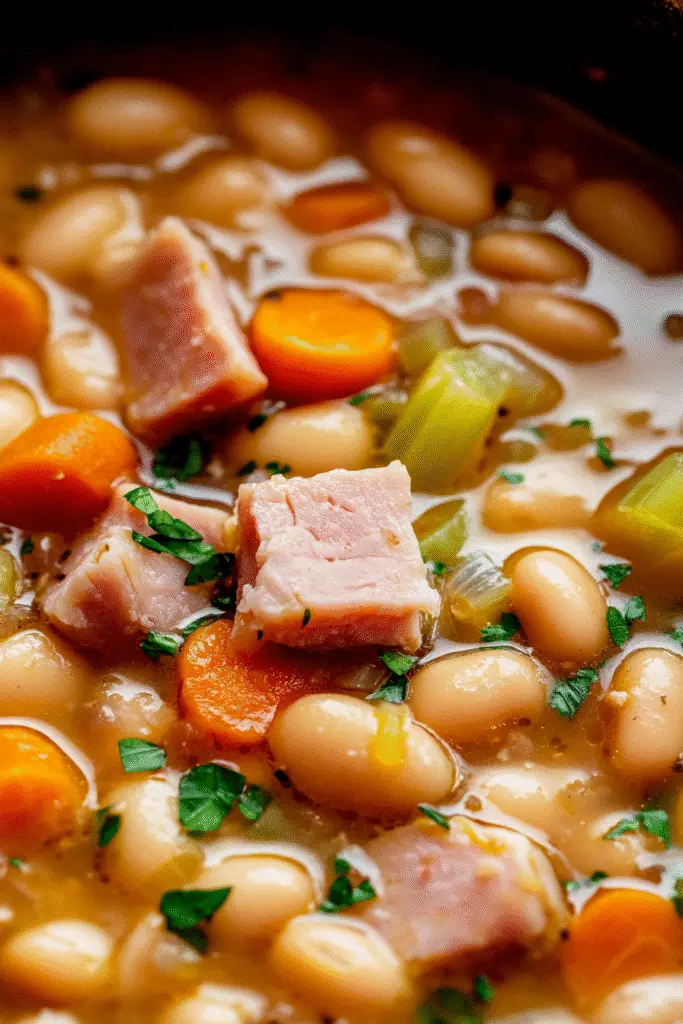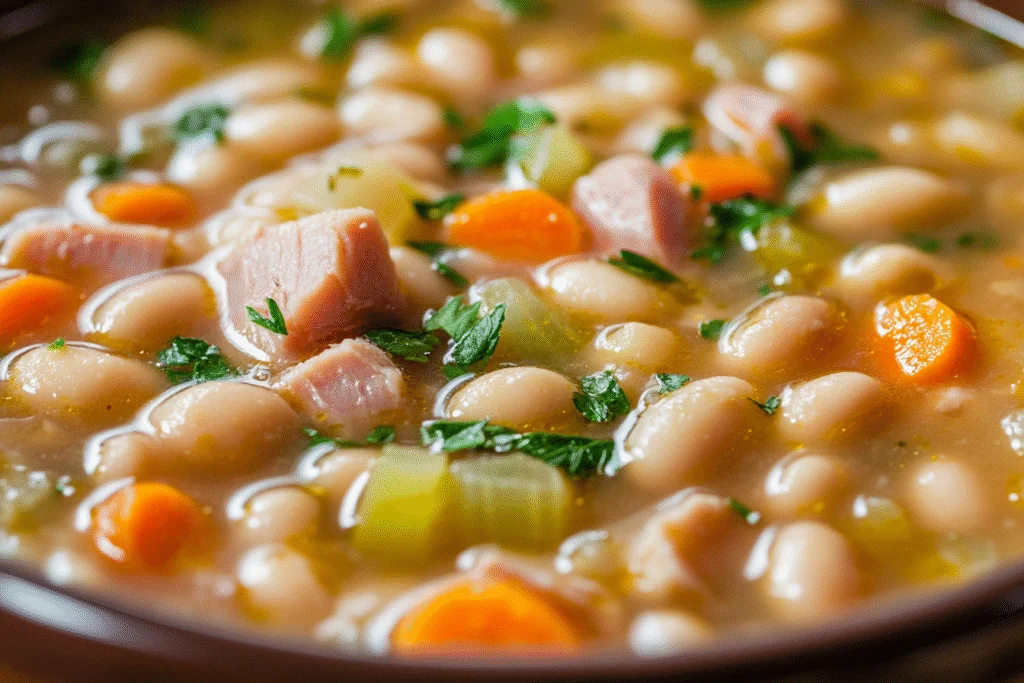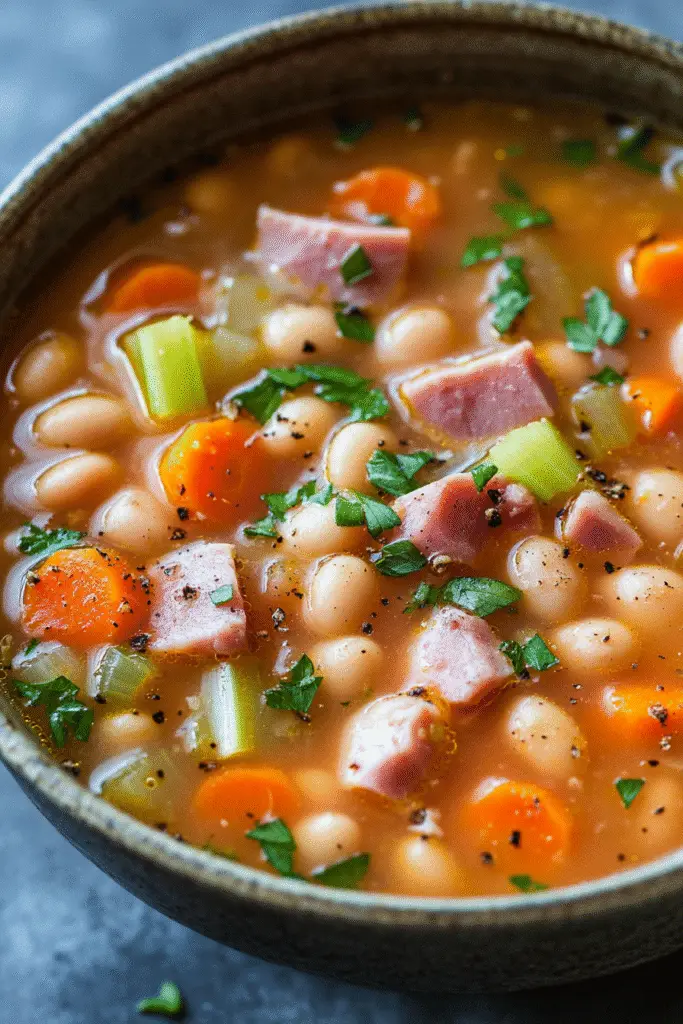Ham and Bean Soup is a timeless, rustic dish that brings comfort and warmth to every bowl. Perfect for chilly days, using up leftover ham, or creating a hearty, nutritious meal that feeds a crowd, this soup is all about savory depth, tender beans, and satisfying textures. Whether it’s made with a leftover ham bone, a smoked ham hock, or diced ham, the result is always a flavorful, slow-simmered soup that tastes like home.
In this comprehensive recipe guide, I’ll walk you through every essential detail to make an excellent ham and bean soup from scratch. We’ll cover the best beans to use, how to build a flavorful base, practical time-saving tips, and troubleshooting common issues like blandness or mushy beans. I’ll also share helpful variations, storage advice, and make-ahead strategies to fit your cooking schedule.
Why Ham and Bean Soup Works: A Simple Yet Deeply Satisfying Dish
The beauty of ham and bean soup is in its balance of hearty, savory, and nourishing elements.
- Savory ham adds richness and infuses the broth with meaty flavor.
- Tender beans provide creaminess and body.
- Aromatic vegetables like onion, garlic, carrots, and celery build a fragrant base.
- Herbs and spices give depth and subtle complexity.
This is a soup that feels wholesome, filling, and deeply comforting without being heavy. It’s a perfect meal-prep option because the flavors develop and improve after a day in the refrigerator.

Choosing the Best Beans for Ham and Bean Soup
Dried vs. Canned Beans:
- Dried beans (great northern, navy, cannellini) offer superior texture and absorb flavor better but require soaking and longer cooking.
- Canned beans are faster but can be softer and saltier—still a great option for a quick version.
Best Bean Choices:
- Great Northern Beans: Mild, creamy, and hold their shape well.
- Navy Beans: Soft, tender texture; perfect for thick, hearty soups.
- Cannellini Beans: Larger and slightly firmer; add beautiful creaminess.
Soaking Tips:
- Overnight soak: Best for even cooking and digestion.
- Quick soak: Boil beans for 2 minutes, then soak for 1 hour before cooking.

Selecting the Ham: Bone-In vs. Diced
The ham you use will directly impact the soup’s flavor and richness.
Best Ham Options:
- Leftover ham bone: Adds incredible depth, saltiness, and body.
- Smoked ham hock: Provides a smoky, meaty flavor and collagen for richness.
- Diced ham: Convenient, but you may need to supplement with broth for flavor intensity.
Key Tip:
If using a ham bone, simmer it with the soup and remove it after cooking, shredding any meat left on the bone back into the pot.

Building a Flavorful Broth: The Backbone of the Soup
Aromatics:
- Onion, garlic, carrots, and celery are essential for the base flavor.
- Bay leaves and thyme add subtle herbal notes.
Liquid:
- Low-sodium chicken broth is best to control salt levels.
- Water can be used if you’re using a ham bone, which provides plenty of flavor.
Seasoning:
- Go easy on salt until the ham flavor fully develops.
- Freshly cracked black pepper and optional crushed red pepper flakes add depth.
Recommended Equipment
Most home kitchens will have everything you need:
- Large Dutch oven or heavy soup pot
- Wooden spoon for stirring
- Ladle for serving
- Sharp knife and cutting board for prepping vegetables and ham
Optional: Immersion blender if you like a partially puréed, thicker soup.
Common Mistakes and How to Avoid Them
1. Bland Flavor
- Happens when the broth isn’t properly seasoned or developed.
- Solution: Use a ham bone or smoked ham hock to infuse the soup with rich flavor. Simmer long enough for depth.
2. Mushy Beans
- Caused by overcooking or using canned beans without careful timing.
- Solution: If using canned beans, add them in the last 15–20 minutes to prevent over-softening.
3. Over-Salty Soup
- Ham and broth can be quite salty.
- Solution: Use low-sodium broth and season to taste at the end.
4. Thin or Watery Soup
- If too much water is used or if beans don’t break down.
- Solution: Simmer uncovered to reduce, or lightly mash some beans to naturally thicken the soup.
Preparation and Meal Planning Tips
Make-Ahead Friendly:
- The soup tastes even better the next day as the flavors meld.
- Can be refrigerated for up to 4 days or frozen for up to 3 months.
Time-Saving Option:
- Use canned beans and diced ham to cut total cooking time to about 45 minutes.
Batch Cooking:
- This soup doubles well for larger gatherings or meal prep.
Flavor Variations and Custom Add-Ins
Hearty Additions:
- Potatoes: Add cubed Yukon Gold potatoes for extra body.
- Greens: Stir in spinach, kale, or Swiss chard at the end for freshness.
Spice Boosters:
- Add smoked paprika, cayenne, or crushed red pepper flakes for a subtle heat.
Protein Swaps:
- Use smoked turkey leg instead of ham for a lighter, smoky option.
Herb Variations:
- Fresh rosemary, sage, or dill can offer a different aromatic profile.
Ingredient List
For the Soup:
- 2 tablespoons olive oil
- 1 large onion, diced
- 3 cloves garlic, minced
- 2 large carrots, diced
- 2 celery stalks, diced
- 1 pound (450 g) dried great northern beans (or 3 cans, drained and rinsed)
- 6 cups (1.4 liters) low-sodium chicken broth
- 1 leftover ham bone or 2 cups (300 g) diced ham
- 2 bay leaves
- 1 teaspoon dried thyme
- Salt and black pepper to taste
- Optional: ½ teaspoon crushed red pepper flakes
For Garnish:
- Chopped parsley
- Additional diced ham
- Crusty bread on the side
Step-By-Step Instructions
1. Sauté Aromatics
In a large Dutch oven, heat olive oil over medium heat.
Add diced onion, carrots, and celery. Sauté for 5–7 minutes until softened.
Add minced garlic and cook for another 30 seconds until fragrant.
2. Build the Broth
Add ham bone (or diced ham), bay leaves, thyme, and chicken broth.
If using dried beans, add them now.
Bring to a boil, then reduce heat to low and simmer, covered, for 1.5–2 hours, stirring occasionally, until beans are tender and soup is flavorful.
If using canned beans, add them after about 45 minutes of simmering.
3. Adjust Seasoning
Remove the ham bone, shred any meat, and return it to the pot.
Season with black pepper, red pepper flakes, and salt as needed.
Simmer uncovered for another 10–15 minutes to thicken slightly.
Optional: Lightly mash some beans with a spoon to naturally thicken the soup.
4. Finish and Serve
Discard bay leaves.
Ladle soup into bowls and garnish with fresh parsley and additional diced ham if desired.
Serve hot with crusty bread or warm rolls.
Troubleshooting and FAQs
Can I make this soup in a slow cooker?
Yes. Cook on low for 6–8 hours or high for 3–4 hours. Add canned beans in the last hour to prevent over-softening.
How do I prevent the soup from becoming too salty?
Use low-sodium broth and add salt only after the ham and broth have simmered. Ham naturally infuses salt.
Can I freeze ham and bean soup?
Absolutely. Cool completely, store in freezer-safe containers, and freeze for up to 3 months. Thaw overnight in the fridge and reheat gently.
How can I thicken the soup?
Mash some beans in the pot or simmer uncovered to reduce the liquid.
Variations: Classic, Smoky, and Vegetable-Packed Versions
| Version | Protein | Bean Type | Key Notes |
|---|---|---|---|
| Classic | Ham bone or diced ham | Great northern or navy beans | Traditional, hearty, comforting |
| Smoky | Smoked ham hock or turkey leg | Navy beans | Deep, smoky flavor |
| Vegetable | Ham or vegetarian | Cannellini beans | Add greens, potatoes, or extra vegetables |
Each version provides a satisfying base with room for customization.
Storage and Reheating Tips
- Storage: Refrigerate in an airtight container for up to 4 days.
- Reheating: Warm gently on the stovetop or in the microwave, stirring occasionally.
- Freezing: Freeze in portions for up to 3 months. Thaw overnight and reheat thoroughly.
Final Thoughts
Ham and Bean Soup is a wonderfully simple, satisfying dish that brings together savory ham, tender beans, and rich broth in the most comforting way. Whether you make it with a ham bone, diced ham, or a smoky ham hock, it’s a meal that feels like a warm, cozy embrace.
Perfect for feeding a family, using up leftovers, or prepping for easy lunches, this soup is deeply versatile and endlessly customizable. I hope this guide helps you make your ideal version—whether you keep it classic, add greens, or spice it up to suit your taste!
